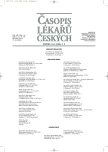Epidemiological Aspects of the Female Urinary Incontinence
Epidemiologické aspekty ženské močové inkontinence
Močová inkontinence je definována jako nechtěný únik moči, který způsobuje sociální a hygienický problém. Je symptomem, který má různé příčiny. Podle typických klinických projevů dělíme inkontinenci na stresovou, urgentní, reflexní a paradoxní. Stresová inkontinence se projevuje únikem zpravidla malého množství moči při fyzických aktivitách spojených s náhlým zvýšením intrabdominálního tlaku (při kašli, kýchnutí, nebo běhu). Urgentní inkontinence se projevuje náhlým neovladatelným nucením k mikci s únikem většího množství moči. U reflexní inkontinence se močový měchýř vyprazdňuje bez nutkání a reflexně. Paradoxní inkontinence je způsobená získanou slabostí svaloviny močového měchýře a projevuje se neúplným vyprazdňováním se zvětšujícím se močovým reziduem. Prevalence močové inkontinence stoupá s věkem. Významný nárůst symptomů inkontinence je v průběhu 5. a 6. dekády života. Močovou inkontinenci lze u žen v mladém a středním věku považovat více za dynamický než trvalý symptom, ale inkontinence v postmenopauze zpravidla spontánně neregreduje. Urgentní a smíšená inkontinence se ve srovnání se stresovou symptomatologií vyskytují v nižším procentu (kolem 10–15 %). Pouze 1,5–6 % inkontinentních žen v souborech hodnotících prevalenci a incidenci močové inkontinence hledá lékařskou pomoc. Pacientky s urgentní inkontinencí hledají pomoc obvykle častěji než ženy se stresovou inkontinencí, protože urgentní symptomatologie je zpravidla sociálně a hygienicky více omezující.
Klíčová slova:
močová inkontinence, typy inkontinence, epidemiologie, prevalence, kvalita života.
Authors:
Roman Chmel
; Marta Nováčková
; R. Vlk; L. Horčička
Authors‘ workplace:
Gynekologicko-porodnická klinika 2. LF UK a FNM, Praha
Published in:
Čas. Lék. čes. 2005; 144: 95-97
Category:
Review Article
Overview
Urinary incontinence is defined as an involuntary loss of urine, which makes social and hygienic problem. It is a symptom with different causes. According to the typical clinical manifestation it is classified as stress, urge, reflex and paradox urinary incontinence. Loss of small amount of urine related to the increase of intraabdominal pressure (during coughing, sneezing or running) is characteristic for stress urinary incontinence. Sudden and uncontrollable voiding with loss of greater amount of urine is typical for urge incontinence. Reflex incontinence means that urinary bladder is emptying without voiding. Paradox incontinence is caused by an acquired smooth muscle weakness of the bladder and it manifests with incomplete emptying and with growing residual urine. Prevalence of urinary incontinence increases with age. Significant increase of female urinary incontinence symptoms is found in fifth and sixth decade. Urinary incontinence in young women is more a dynamic than a permanent symptom but the postmenopausal incontinence obviously does not disappear spontaneously. Urge and mixed incontinence are less frequent than stress symptomatology (between 10 and 15 %). According to the prevalence studies only 1,5 to 6 % of incontinent women are looking for a medical help. Because the urge symptoms are more limiting, the patients with urge incontinence are searching treatment possibilities more often than those with stress incontinence.
Key words:
urinary incontinence, types of incontinence, epidemiology, prevalence, quality of life.
Labels
Addictology Allergology and clinical immunology Angiology Audiology Clinical biochemistry Dermatology & STDs Paediatric gastroenterology Paediatric surgery Paediatric cardiology Paediatric neurology Paediatric ENT Paediatric psychiatry Paediatric rheumatology Diabetology Pharmacy Vascular surgery Pain management Dental HygienistArticle was published in
Journal of Czech Physicians

- Metamizole vs. Tramadol in Postoperative Analgesia
- Metamizole at a Glance and in Practice – Effective Non-Opioid Analgesic for All Ages
- Advances in the Treatment of Myasthenia Gravis on the Horizon
- What Effect Can Be Expected from Limosilactobacillus reuteri in Mucositis and Peri-Implantitis?
- The Importance of Hydration in Wound Healing
Most read in this issue
- Molecular Genetic Study of Causes of the Prader-Willi and Angelman Syndrome
- Psychiatry is More Than Therapy
- Current and Perspective Treatment of Chronic Lymphocytic Leukemia
- Therapy of Acute Myocardial Infarction in Unspecialised Medical Centres – Evaluation of Diagnostic and Therapeutic Practice
